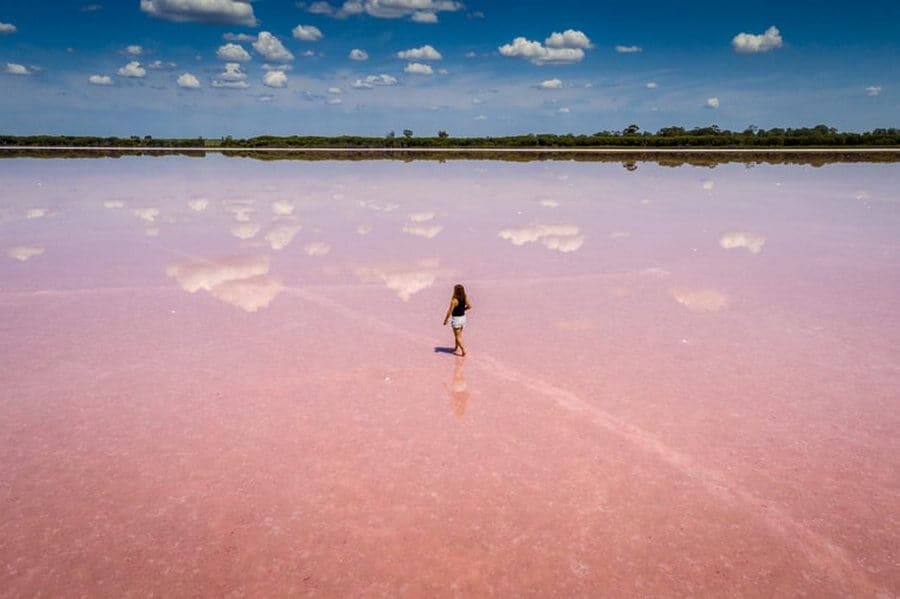Nature is Earth’s way of showcasing just how remarkable it is. All throughout the world, some of the most beautiful places are within the natural landscape of the planet. Many of these gorgeous places are beyond breathtaking while others are also quite unique.
Australia is a central hub for unique and striking naturalistic views. It has plenty of places in nature to visit but its lakes are perhaps among the most interesting to see.
From coast to coast (and even offshore), Australia’s lakes are some of the most incredible lakes in the world. Places like Fraser Island, off the eastern coast of the country, are home to perched lakes where the water is extremely pure, clear, and pristine. The country’s perched lakes certainly draw in visitors for their uniqueness.
While swimming is considered generally safe in most of Australia’s pink lakes, it isn’t a common occurrence. The lakes are appreciated for their stark colour and how beautifully contrasted they are to their surroundings. Many people choose to take photos and not go swimming in the pink lakes.
However, these aren’t the type of lakes that Australia has that peaks the interest of its residents and tourists. There are pink lakes that look something out of a sci-fi movie with their bright pink hues. These pink lakes and their interesting colour might seem intimidating but there is a lot to learn from them.
Australia isn’t home to just one pink lake or even a small cluster of them. The country has around 10 pink lakes with most of them being in Western Australia. Theoretically, you could swim in the pink lakes that are found throughout the country, however, it might not be the most pleasing experience.
The waters in these lakes have astronomical amounts of salt in them and some of the pink lakes, like Lake Hillier
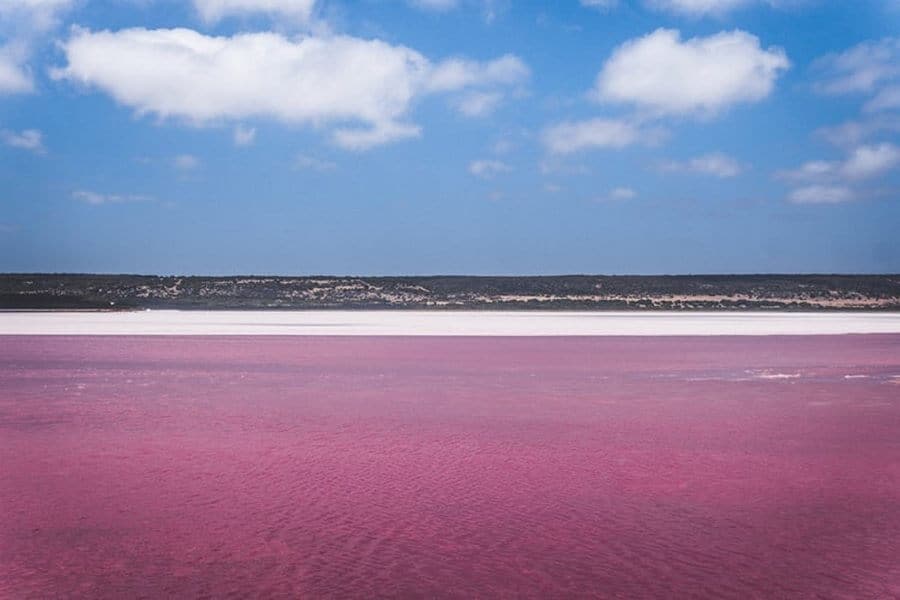
While there are challenges surrounding swimming in the various pink lakes, they are still a remarkable part of nature to experience. In some spots, like the Hutt Lagoon
Before considering wading into the cotton-candy-like waters, it is important to understand why the waters have the colour that they do. It is equally important to know where the pink lakes can be found around Australia so that people can decide which ones they want to visit.
Ultimately, taking photos of the opaque pink lakes is the best way to enjoy them. Below is some insight into why are pink lakes pink in the first place as well as where pink lakes can be found in Australia.
Why Are The Pink Lakes Such A Vibrant Pink?
Over the years, there have been many studies conducted to determine the exact source behind the lakes and their whimsical colour. The colour is said to derive from the salt content found in the lake as well as from algae that are known to thrive within the salty environment.
While the algae, especially the species, Dunaliella Algae

These algae and bacterium are known for their reddish-pink hues which essentially means that they produce what is called “carotenoid” beta-carotene which is a colouring agent.
The high salt content of the pink lakes aids in extracting the colours from these creatures. Additionally, depending on what lake it is and what specific species are found in the water, the lakes’ water can appear lighter pink, darker pink, and even shades of purple.
Moreover, it can also appear to not be pink at all, although this is less common.
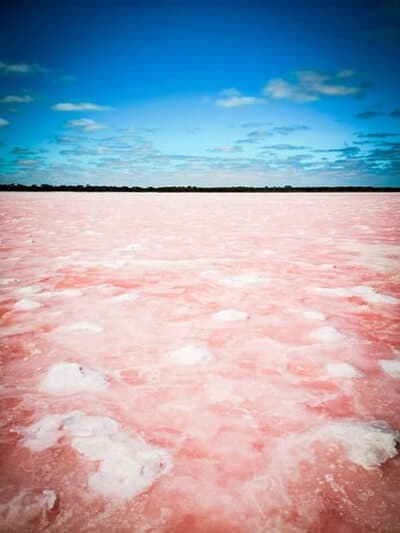
To really get a better grasp on how salinibacter ruber thrives within the pink lakes, it is important to note that these bacterium only survive where crystallised salt contents are significantly higher. Generally, these bacteriums cannot survive in waters that have less than 15% salt concentration.
Alternatively, they survive best in waters that contain somewhere between 20-30% of salt concentration.
Because of this, it is easier to imagine just how much salt is concentrated within the pink lakes around Australia. Due to their high concentration of salt, the bacterium can thrive, producing more of the pink colouring.
The algae play a lesser part in the lakes’ colour, however, they are still a vital part of the overall ecosystem.
This fascinating process of the algae and bacterium shading the water with pink is a great example of how mother nature is always producing organic art. While swimming is possible in some of the pink lakes around the country, it isn’t advised because it could disturb the balance that exists within the ecosystems of the lakes.
Much like how sun lotions aren’t permitted in perched lakes due to the purity of their waters.
Wading in the water and taking opportunities to snap photographs are the ideal way to enjoy Australia’s pink lakes. Not only does it help preserve the lakes and their ecosystems but it helps maintain respect for things that nature produces.
What Are Australia’s Pink Lakes And Where Are They Located?
Even though pink lakes are usually associated with Western Australia, some can be found a little further east and south of there. Below are the known rosy-pink lakes that Australia has!
Pink Lakes Throughout Australia
Lake Hillier (Western Australia)
Lake Hillier
The lake is in a pretty remote area and isn’t easily accessible. It is around 600 metres in length and 250 metres wide, making it quite large. The best way to view the lake is by helicopter. It is one of the pink lakes in the country that continuously has its bright colour even when it is removed from the lake.
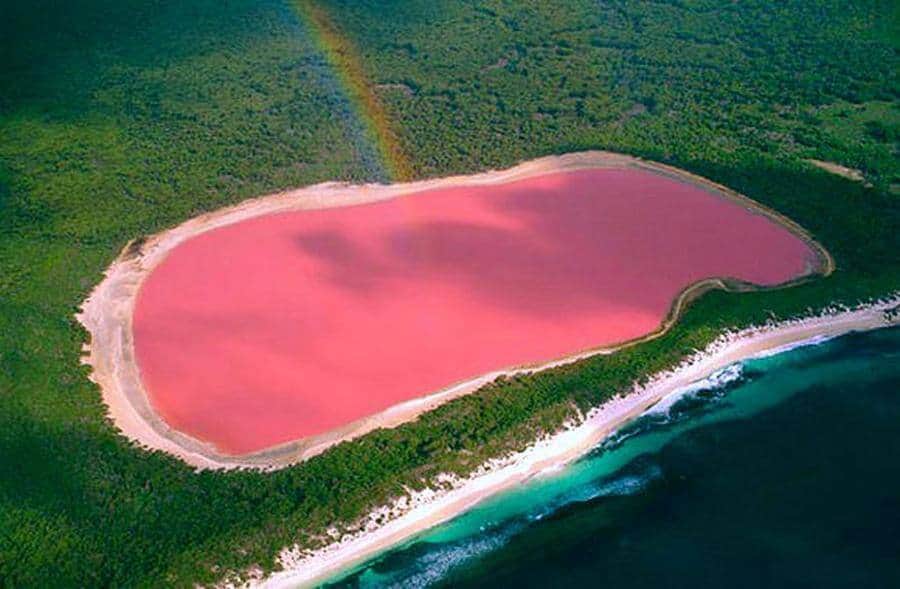
Pink Lake And Lake Warden (Western Australia)
These two lakes aren’t very far from Lake Hillier and Pink Lake often is mistaken for its neighbour. However, Pink Lake is often a source of disappointment for visitors because the lake has lost a lot of its hue over the years. This is primarily due to construction around the area that has had a negative effect on the natural surroundings.
Lake Warden
The lake has a depth of about 2 metres and has been getting shallower throughout the years due to deforestation. Regardless, it is a better view for a sight of pink water over Pink Lake.
Hutt Lagoon (Western Australia)
Aside from Lake Hillier, Hutt Lagoon
It stretches about 70 square kilometres and sits adjacent to the Indian Ocean, regularly getting water through the barrier ridge that parts from the ocean.
The lagoon is a popular spot due to its ideal location near the ocean. It is in Port Gregory and sits along the Coral Coast Highway in Western Australia. Because of its proximity to the ocean and the highway, visitors often stop by to admire the natural phenomenon of the water’s colour.
The lagoon has also been featured in various photoshoots of models.
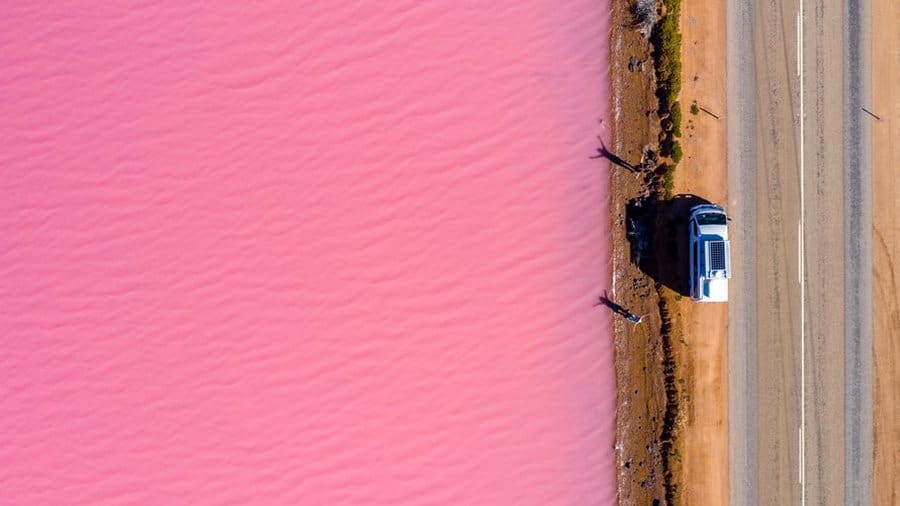
Westgate Lake (Melbourne)
Tucked away in Westgate Park
All of these factors are said to contribute to the water’s beautiful colour.
Due to the external factors that aid in the lake’s colour, it is said that the best way to see the colourful water is between 10 a.m. and 2 p.m. when the sun is directly over the lake. This prime opportunity gives visitors the best view of all the lake’s pink glory.
Moreover, going during a warmer part of the year will also yield better results.
Pink Lakes (Victoria)
In the far northwest of Victoria is a small cluster of four lakes that are known for their various pink hues. These lakes are known as Lake Crosbie


The colours fluctuate between light red and bright pink and slowly become whiter as the day progresses. Additionally, rainfall is known to affect the lakes and their colours.
Access to these lakes is perhaps the easiest out of Australia’s pink lakes with the exception of the Hutt Lagoon (since it is near the highway). There are even walking tracks that wind through the lakes which is a great way to enjoy the surroundings and the lakes themselves.
Along with the other pink lakes in Australia, there is something truly fascinating about seeing the stark colours of the lakes, sky, and nearby waters meld together!
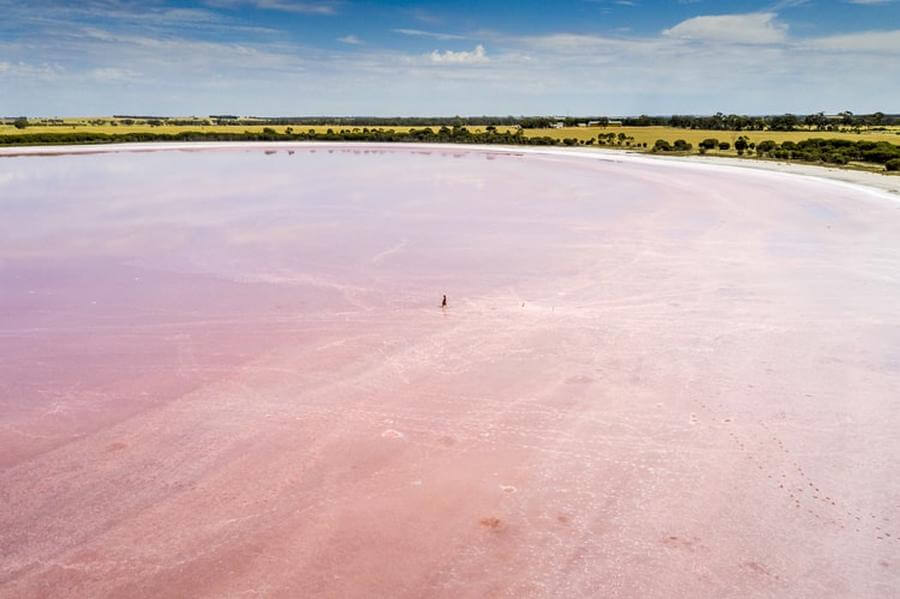
Lake Bumbunga (South Australia)
This lake is one of the shallowest lakes in Australia. Because of its extremely shallow waters, it is perfect for walking through. It appears to look like an open pink desert over a body of water. However, stepping into its waters shows that even though the depth isn’t much, there is water present!
Moreover, the shallow water makes the lake a great source for salt mining. It might not be as pronounced as the other pink lakes, but it is still a drastic pink colour!
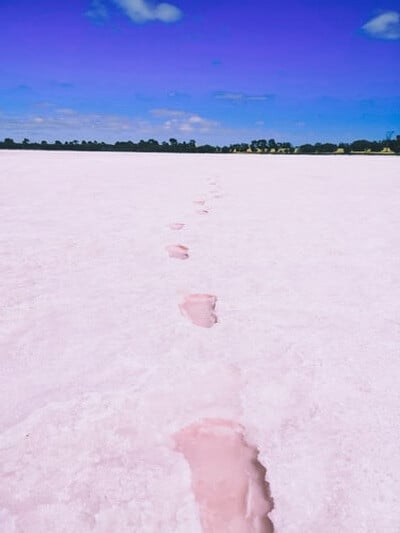
Lake MacDonnell (South Australia)
Lake Macdonnell
It is extremely remote and sits near the Nullabor Plain.
It is an astonishing 9-hour drive from Adelaide and its closet town, Penong which is about 13 minutes north of the lake.
These bodies of water are all unique in their own way. While they all share a pink discolouration of their waters, the lakes still have slight differences such as location or surroundings that make them stand apart from one another.
While swimming in the lakes isn’t generally recommended, taking videos or photos of them is highly encouraged!
What Happens If You Swim In The Pink Lakes?
There’s a concern surrounding swimming in the pink lakes where it is thought that people’s skin might become stained pink. In theory, this could happen but more than likely it wouldn’t. Swimming in waters with high salt content for prolonged periods of time could cause mild skin irritation.
This is an unpleasant side-effect of staying in overly salty water. Considering the high content of salt in pink lakes, this is a big possibility.
The biggest issue with swimming in the pink lakes is the potential to contaminate the balance of nature within the waters of the lake. In order to really preserve their ecosystems, it is a good idea to not get too tempted to take a dip.
Respecting the ecosystem’s boundaries and sticking to taking pictures (or wading) is the ideal way to enjoy what the pink lakes offer their visitors.
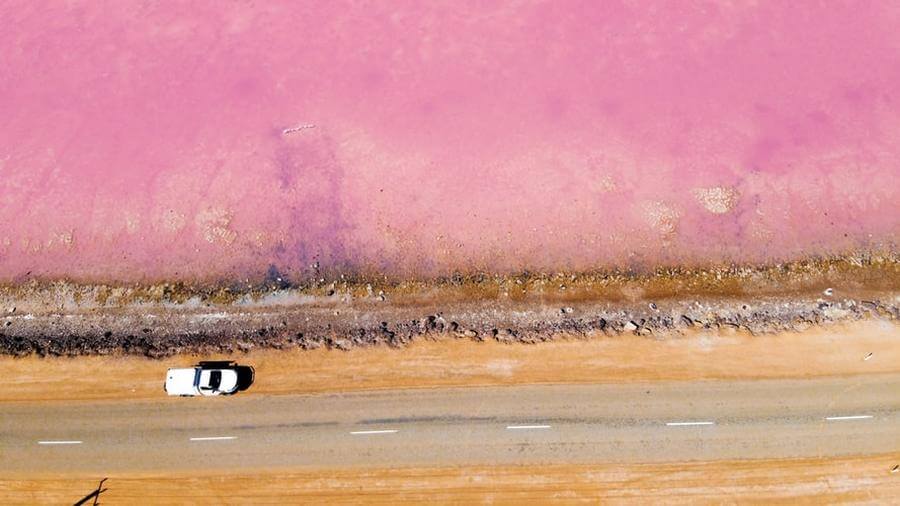
Are The Pink Lakes Dangerous?
The short answer to this is no. The lakes do not pose a danger to the public. The algae and bacterium aren’t a danger and previous myths about the strange colour have more or less been debunked. Initially, due to the extreme colour of the water, theories swarmed around saying that it was pollution of some sort.
However, extensive research has shown that the crystallised salt content of the water, the algae and bacterium, and weather are the biggest reason behind the pink.
The appearance of these lakes might be offsetting to some people but overall they aren’t posing any real danger to anyone or the environment. As expressed before, their colour is a huge part of their ecosystems.
For the most part, people are mesmerized by the bubblegum tint and simply find it fascinating to witness in person.
Australia continuously proves to be one of the world’s most extraordinary countries with all that its natural surrounding has to offer!
More Pages on Tips
Beaches with white sands and turquoise waters are the ideal holiday destination. However, you must ensure that you plan your budget for your vacation. So how much should you save up for a beach...
One of the biggest drags about being an adult is having to work. Most people would probably say they aren't happy with their job situations. Doing the 8 hours (or more grind) isn't everyone's cup of...


